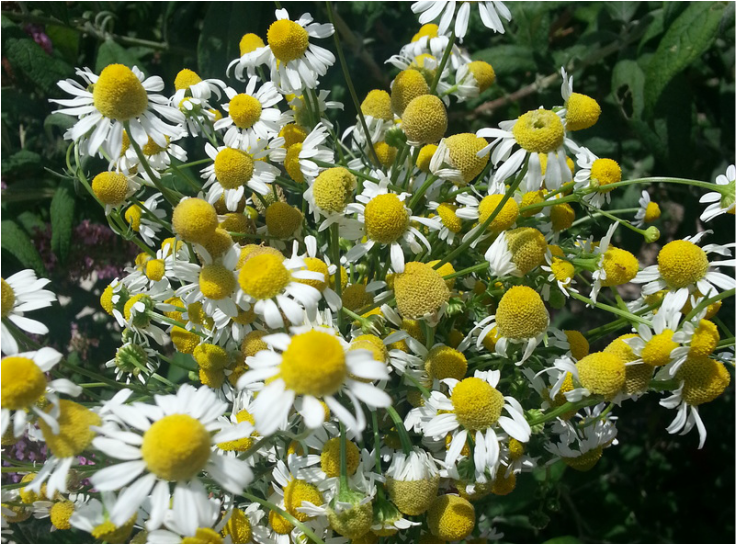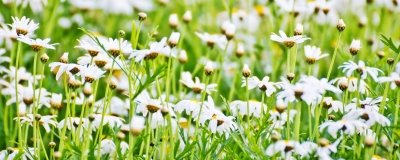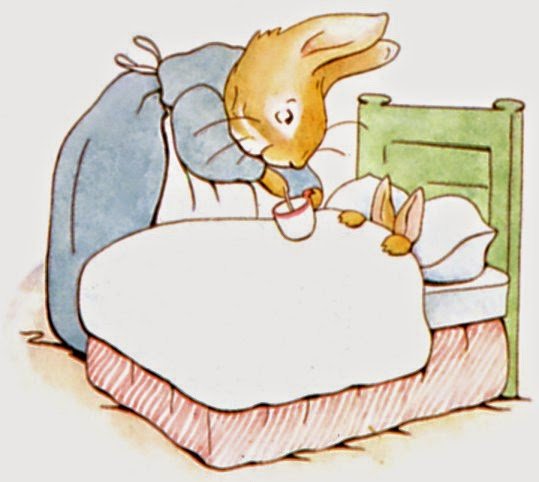
Bouquet of German chamomile. Image by Jennifer Capestany.
For so many of us German chamomile (Matricaria recutita) was our first introduction to herbs as a remedy. We were given cups of hot, honey sweetened chamomile tea when we were sick, had a tummy ache, or had trouble turning ourselves off at night. Chamomile soothed and calmed with its gentle, yet steady action, helping us to digest our food better and slip off to sleep.
It’s that gentle reputation that has made this member of the Asteraceae family so popular as a safe herb for children. Don’t let chamomile fool you though. She’s neither weak, nor just for the very young. She’s there for us when we aren’t feeling quite ourselves, whether that’s from:
- a tummyache
- an overactive mind
- a stuffed up head
- dealing with an inflammatory disorder
- or living on the edge of our nerves
So grab a cup of this aromatic, golden tea. Let's get into German chamomile, and talk about how we can grow, store, and best use her wonderful benefits!
How to Grow Chamomile

Image by Jennifer Capestany.
German chamomile is a hardy annual with small, daisy like flowers. The foliage grows in a spreading manner with many blossoms shooting up from thin stems in the summer.
The seeds need light to germinate, so either grow them indoors in a very sunny window or under a grow light about 4-6 weeks before last frost. You can also sow the seed outdoors in spring after all danger of frost is past. Don’t plant them deeply, and cover lightly with soil. Germination usually takes place in 5-14 days.
Chamomile is quite hardy, tolerant of a range of sun exposures from full sun (even Texas sun) to partial shade. Avoid deep shade though. These happy flowers really do prefer the sunshine. Chamomile can tolerate a range of soils, including poor quality. Well draining, nutrient rich is best though. Water moderately. Don’t allow the soil to remain damp. Where I live in North Texas, for example, rain can be feast or famine, and black clay (We call it gumbo.) dominates the soil. When the rainy season comes, flooding and over-saturation of the soil can become a problem. I find that planting in raised or mounded beds go a long way toward encouraging proper drainage. Chamomile thrives for me when grown this way.
A prolific grower, chamomile loves to spread, making it unsuitable for container gardening. German chamomile grows 20-30 inches high, and can easily spread that wide as well, possibly wider. Be sure to give it lots of grow space. Recommended planting distance is 15 inches.
Need pollinators? Call on chamomile. The blooms attract bees and butterflies.
This plant self sows readily. Don’t be surprised if chamomile pops up again in your garden next season. Harvest the flowering tops frequently if this isn’t desirable.

Image courtesy of Feelart at FreeDigitalPhotos.net
Companion Planting
As a companion plant, chamomile improves the vigor of just about every plant that it grows near, but not in large quantities! Because it can take over quickly, one plant in a mixed bed or garden is often enough. Give it room to spread.
Cabbages and cucumbers are especially fond of chamomile.
Chamomile is also a host plant for wasps and hoverflies, making it a fine choice for encouraging natural pest controls.
Harvesting and Storage
Harvest only the fresh looking blossoms that haven’t browned in color. The blossoms are the most potent, though leaves can be combined with the blooms to make full strength infusions.
Dry the blossoms and store them in a cool, dry place. This herb, perhaps the most well known herb in the Western world, has many, many uses in herbal medicine. Let’s take a quick look at them.
Herbal Remedies
Think of chamomile as your ally in situations of nervous tension like:
- frazzled nerves
- general anxiety
- tummyaches
- restlessness
- an inability to "turn off your brain"
- muscle tension
- PMS and its associated cramping
Chamomile’s anti-inflammatory and antimicrobial properties also make it a fine herb to turn to for dealing with colds, rashes, minor wounds, certain infections (like gingivitis), inflamed or infected sinuses, a host of inflammatory conditions (including cancer), and many digestive issues including stomach cramps, diarrhea, Crohn’s disease and ulcers.
Even Western science has been able to document chamomile’s effectiveness. A 2009 study demonstrated chamomile’s soothing properties by showing that “chamomile may have modest benefits for some people with mild to moderate GAD [generalized anxiety disorder]. "
Another study published that same year showed promising anti-inflammatory action in vitro as compared to a prescription NSAID. This was done using a freeze dried version of the tea. The study noted:
“These findings add a novel aspect to the biological profile of chamomile which might be important for understanding the usefulness of aqueous chamomile extract in the form of tea in preventing inflammation and cancer.”
Life Sci. 2009 Nov 4; 85(19-20): 663–669.
Certainly the most popular way to use chamomile is in tea form. There’s a reason for this. The active constituents of chamomile readily and quickly release into hot water, making the tea an effective remedy. Part of chamomile’s magic is in its volatile (essential) oils, which you can experience by inhaling that lovely floral aroma as you drink. Chamomile’s mildly sweet taste is pleasant and easy to “sell” to picky children over a pill or tincture. A 10 minute steep of 1 heaping teaspoon of the dried flowers with 8oz of hot water is sufficient.

Image courtesy of Serge Bertasius Photography at FreeDigitalPhotos.net
Tea is not the only way that you can use this all purpose herb!
Rosalee de la Foret of Herbal Remedies Advice brings us a cooling and fun chamomile popsicles recipe.
Chamomile finds its way into many balms, lotions, and creams, due to its ability to assist in minor wounds and rashes.
The infused honey can help to soothe coughs and achy tummies. It also makes a fantastic face cleanser.
The essential oil is useful in diffusers, balms, and baths.
Chamomile tincture is a potent remedy form, and useful in situations where a strong dose is needed.
Got a stuffy nose? Learning Herbs’ John Gallagher shows us how chamomile can help.
Where to Buy
Large quantities of fresh chamomile flowers become small quantities when dried. If you find that you cannot grow enough to meet your needs, then look for an organic source online or at your local organic market. Buy in bulk. Now that you know what to do, it won’t go to waste.
Warnings
Chamomile is classed as safe for children. It’s considered fine for everyday use, and only very rarely causes side effects. A very few with existing ragweed allergies may find that chamomile triggers a reaction. If so, avoid products that contain chamomile.

Peter Rabbit's mama, about to dose him with chamomile tea after his binge and fright in Mr. McGregor's garden. Image in the public domain.
Like the mother that she’s named for, chamomile reaches out to us with gentle, yet strongly supportive hands. Turn to "good for everything" chamomile at any age to help bring you back to tranquility.
Editor's Note: The information in this article is not intended to diagnose or treat illness. Always do your research before using an herbal remedy to ensure that there are no allergy risks or cross indications with any prescription medications that you are taking. See your doctor before starting any new treatments or programs. Anything that you learn from Prairie Hawk Botanica, its blog, or Jennifer Capestany must be considered informational only. You own yourself. Article originally published on Prairie Hawk Botanica's Blog. Shared by me, the original author and owner.

You may also like: Herbal Remedies for Earaches & Ear Infections / DIY Herbal Remedies: How to Make an Herb Infused Oil / How to Make Herbal, Medicinal Honey / Natural Remedies for Cold Sores / My Story: Healing from Rheumatoid Arthritis & Finding My Calling / Tips for Reducing Chronic Inflammation / On Insecurity.
Author: Jennifer Capestany
Jennifer is a clinical herbalist and health coach, specializing in autoimmune diseases like rheumatoid arthritis. Her interest in plant medicine led Jennifer to spend years studying herbology, physiology, and nutrition. She works one-on-one with her clients via her herbalist and health coaching business, Prairie Hawk Botanica. Jennifer lives on a homestead in rural Texas with her husband, 2 children, and various animals. In her spare time she loves to be in her large herb and vegetable garden. Sharing herb knowledge and her love of natural healing with others is her calling.
very interesting post....voted and follow...
...try to search to find out what is the words' chamomile true meaning ....and how this herb got its name...its very interesting as well...
Thanks, @funnel!
Well researched and written post. Loved all the info on chamomile.
Great how-to. I'm a little sick right now. This helps. Thanks, Jenn.